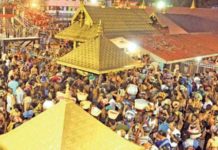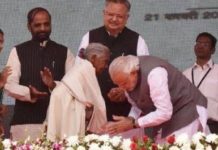India, the great country of ours is tagged with an attribute of not invading even a single territory. However, we tend to forget an important fact that Hyderabad state, which was under the rule of Nizams since the 16th Century, was annexed by our own country of India on 17th of September, 1948. Sardar Vallabhai Patel, the then home minister asked the Nizam to sign the instrument of accession. The disagreement of Nizam to do so led him to seek the advice of the then Governor-General Lord Mountbatten who advised Mr. Patel to use force and conquer the province of Hyderabad. The Nizam’s efforts also triggered the largest agrarian armed rebellion in modern Indian history. To deter the Nizam, Indian union chose to implement an economic blockade, which forced the state of Hyderabad to sign a Standstill Agreement with it.
In the meanwhile, the chief of the Majlis-e-Ihtehaat-ul-Muslimeen, Qasim Razvi, had set up a voluntary militia called “Razakars”(meaning ‘volunteers’). These Razakars vowed that they will fight for the independent country of Hyderabad against the Independent India. The number of Razakars grew at a very fast pace and it is estimated that by 17th of September of 1948 there were around 2,00,000 Razakars. In Telengana, large groups of peasants revolted against local Hindu and Muslim landlords, and also came into direct confrontation with the Razakars, in what was known as the Telangana Rebellion.
Finally the day of 17th September, 1948 came on which the Hyderabad state was annexed as a result of a police action named Operation Polo and the dominion was merged into the Indian Union.
Elections were held in the State of Hyderabad for State Government in 1952 which led to the victory of the Congress party and Burgula Ramakrishna Rao became the first Chief Minister. In the extreme south, Madras state comprised of the present Tamil Nadu, Coastal Andhra and Rayalaseema(13 Districts of present Andhra Pradesh). Potti Sriramulu, a man who wanted the Andhra region to get separated from Madras state started agitations and died as a conclusion of his hunger strike. Acting upon this, the Government of India bifurcated the state of Madras and formed a new state named Andhra with Kurnool as its capital.
Later, the Indian Government established a commission called “State Reorganisation Commission” under the leadership of Justice Fazal e Ali in 1955. Justice Fazal e Ali tabled the report in 1956 which suggested to have the states demarcated on linguistic basis. However, the report also said that though Telugu is spoken both in Andhra and Telangana, status quo was to be maintained with the state of Telangana without any merger with Andhra. But, the Andhra people were very much interested in having a merger with Telangana considering the immensely developed city of Hyderabad. Acting on this, a Gentlemen’s Agreement took place between few Leaders of Telangana and Andhra in which it was agreed that Telangana would not be neglected in development and equal share would be given to this area. The then Prime Minister of India, Jawaharlal Nehru commented on this and said that this was like a marriage between a mischievous boy and an innocent girl and if the people of Telangana desire to separate from Andhra, they can do it.
On 1st of November, 1956, Andhra Pradesh was formed which comprised of Telangana(10 Districts), Coastal Andhra and Rayalaseema(13 Districts) on the basis that the people of all these areas speak Telugu. [Note : Telangana is a word formed by the two words of old Telugu – “Telugu + Anganam” which basically means “The Land of Telugu”. It is also necessary to note that Telangana was a part of Hyderabad state and Hyderabad state also had certain areas which are presently in the state of Karnataka and Maharashtra. ]
Realizing that the agreement hasn’t been enforced and Telangana has been grossly neglected, agitations were started by the students of various Universities in Telangana in 1969. The students got divided into two parts, one demanding the enforcement of the agreement of 1956 and other demanding statehood for Telangana. Chenna Reddy, a politician started Telangana Praja Samithi(TPS) whose main aim was to achieve the state of Telangana. The agitations reached the zenith and the Police started firing randomly which left 369 students dead and thousands injured. This is often called as a Jalianwala Bagh of Independent India where the Government itself ordered the firing over these students. Pro-Telangana activists blame Kasu Brahmananda Reddy the then Chief Minister of Andhra Pradesh belonging to Guntur District of Coastal Andhra region for the massacre and call him General Dyer of Telangana. Meanwhile, Chenna Reddy merged his TPS party into the Congress party on the condition that the Parliament would include a provision for equal opportunities to the people of neglected areas of Andhra Pradesh in the Constitution. An amendment was made to the Constitution to include article 371-D(32nd Amendment). This saw an end of these agitations.
In the Post-1969 period, the Government promised to correct what critics saw as violation to Gentleman’s agreement in jobs, budget allocations, educational facilities. Prime Minister, Indira Gandhi was strongly against the division of the state but on her recommendation, P. V. Narasimha Rao became first Chief minister of Andhra Pradesh from Telangana on September 30, 1971. In 1972, Jai Andhra movement was started which asked for the bifurcation of the state. However, it was suppressed then and there itself.
Later in 2002, a member of Telugu Desham Party(TDP), Kalvakuntla Chandrashekhar Rao(KCR) left TDP and started his own party with the name Telangana Rashtra Samithi(TRS) on the lines of 1969’s TPS. TRS contested the state and center elections in 2004 along with the Congress party which promised separate Telangana if they come into power. Even the Prime Minister Dr. Manmohan Singh in his first press conference said that UPA is committed for the separation of Telangana. However, no action was taken till 2009’s elections. In 2009, TRS joined the third front which had TDP, CPI, CPI(M) in it. However, the Congress party came back to power both in state and center and the third front split up.
Further on 29th of November, 2009, KCR began a hunger strike for separate Telangana just the way Potti Sriramulu did for separate Andhra Pradesh. Eleven days later, on 9th of December, Home Minister Mr. Chidambaram announced on behalf of the Indian Government that “…the process of formation of the state of Telangana would be initiated…”. Unfortunately for Pro-Telangana people, Samaykya Andhra movement was started by various political parties in the regions of Coastal Andhra and Rayalaseema. Around 147 MLAs of AP belonging to the non-Telangana regions submitted their resignations which included the Praja Rayam Party chief Chiranjeevi (note that Chiranjeevi supported Telangana statehood in 2009 elections and fought elections after the merger of Devender Goud’s Nava Telangana Party(NTP) into PRP). Following this unexpected turn, the Indian Government said that it would hold an All Party meet and come to a conclusion. Later, when nothing came out of the meeting, all 11 MLAs of TRS along with 1 BJP MLA submitted their resignations which were accepted without any second thought unlike Anti-Telangana MLAs. Bye elections were held where the resigned MLAs of TRS and BJP won in all 12 constituencies with a huge majority establishing a plebiscite for the bifurcation of the state.
In February 2009, the Indian Government constituted a committee of 5 members under the chairmanship of former judge of Supreme Court, Justice Sri Krishna. Over 60,000 petitions were sent to this committee in a short span of 2 months. On the other hand, the Indian Government published a report regarding the development of the state of Andhra Pradesh in which it stated that 13 of 23 Districts of AP are backward. Interestingly 9 out of 10 Districts of Telangana figured in the 13 backward Districts. Since then, agitations in different regions of AP have been going on and Justice Sri Krishna committee announced that the report will be made by 31st December 2010.
Suggested Readings :















A.G.Noorani on “Operation Polo” and the devastation that the “Iron Man of India” brought on Hyderabad:
http://www.hinduonnet.com/fline/fl1805/18051130.htm
@asad
Gaddar founded Telangana Praja Front on October 3, 2010 and a formal announcement was made at a broad-based convention on October 9.[9]As many people in Telangana believe TRS is mostly used by K.Chandra Sekharrao family for advance of it’s political interests, the Telangana Praja front viewed by those people that it will bring a new dynamic into the demand for Telangana state hood.
marri chenna Reddy accepted the office of Governor of Uttar Pradesh, the most populous State of the country on a reported personal plea of Indira Gandhi made that she required Dr. Reddy’s assistance to help her as the Governor of Uttar Pradesh,her home State. However this is widely seen as a reward for ending the Separate Telangana Movement…..
@ Abhay… True, but Gaddar had no political influence and he just screams all the time to have a bill passed in the Parliament regarding the statehood of Telangana. Moreover, he started his party only after the movement reached dizzy heights. The dead movement was brought to life by K Chandrashekhar Rao. Moreover, there is nothing wrong is having political interests, our constitution itself guarantees to contest and win in the election as a right. To make TPF worse, Gaddar criticizes K Chandrashekhar Rao like hell and I need no reason for that. Is he jealous of him?? and had KCR not started anything like this last year, wouldn’t Gaddar have got kicks today?
@Asad
Do you support telangana?
@ Sai… Yes, I do. However, the above article is an unbiased one.
Hey.
Just read this after a long time. Something came to my notice:
We are all Derrida’s ‘subjects’, aren’t we? To claim something as ‘unbiased’ however hard you try, you cannot remove your personal biases and prejudices when you write. Nothing against what you write, but don’t claim black-or-white opinions in the article. They are bound to reflect themselves in shades of grey.
“Vishalandhra is an idea bearing a faint of expansionist imperialism.”
– Jawaharlal Nehru, October 2, 1953.
“It is like a matrimonial allinace having scope for divorce if it did not work.”
– Jawaharlal Nehru, March 6, 1956
“………it will be in the interest of Telangana if, for the present the Telangana are is constituted into a seeparate state.”
– States Reorganisation Committee, 1956
“………if the public sentiment crystalises itself agains the unification, Telangana will continue as a separate state.”
– States Reorganisation Committee, 1956
“………due to historical reasons it is imperative to continue the protection guaranteed by the constitution in the matter of employment afforded on the basis of resince.”
– Supreme Court of India, 1973
“………had there been no merger of the states there were better chances for this are to get irrigational facilities.”
– Bachawat Tribunal, 1976
Gentlemans Agreement:
Provision of domicile rules.
Reserving income from Telangana for Regional Development.
Government of Andhra Pradesh, G.O.M’s No. 36, 21 January 1969
All non domicile persons, who have been appointed either directly, by promotion or by transfer to posts reserved for domiciles of Telangana region will be immediately….
Government of Andhra Pradesh, G.O.M’s No. 610, 30 December 1985
The employees allocated after 18 October 1975 in violation of the Six Point Formula will be repatriated to their Respective Zones.
Struggle of 1969 (Jai Telangana Movement):
Over 350 students were killed.
Six Point Formula:
All the employees who got employed against rules shall be removed.
Funds siphoned from Telangana must be returned.
Extension of Mulki rules to local administration.
Increase the educational facilities in Hyderabad.
Jai Andhra Movement:
All Mulki rules quashed.
Hyderabad was claimed as free zone.
Period of residence bought down to 4 years.
Water Resources:
River Krishna
69% in Telangana, 65% used by Andhra.
Nagarjunsagar Poject:
Proposed Irrigation Actual Irrigation
15 lakh hectares 5 lakh hectares
Srisailam Project:
Propases Irrigation Actual Irrigation
5 lakh hectares 0 hectares
138 villages lost and over 2 lakh people displaced.
River Godavari
79% in Telangana, 10% is used for irrigation.
Sriramsagar Project:
Proposed Irrigation Actual Irrigation
15 lakh hectares 6 lakh hectares
Polavaram project submerges 250 villages and displaces over 5 lakh tribal people in Telangana.
Economic:
A.P. State Secretariat:
Employees of Telangana origin account for less than 8%.
A.P. High Court:
Employees of Telangana orign account for 20%.
No Advocate-General has ever been appointed from this region.
Over 2 lakh people from Andhra region are employed in Telangana. – Girglani Commission, 2004
10000+ industrial units:
Telangana: 1200
Andhra: 6500
Political:
All Telangana regions combines Chief Ministers’ tenure is hardly 6 years.
Panchayat Raj Divisions:
Andhra: 883
Telangana: 293
Cultural and Social:
Different Accents
Unique festivals
9 backward states in Telangana and 4 in Andhra region.
so do i
“Vishalandhra is an idea bearing a faint of expansionist imperialism.”
– Jawaharlal Nehru, October 2, 1953.
“It is like a matrimonial allinace having scope for divorce if it did not work.”
– Jawaharlal Nehru, March 6, 1956
“………it will be in the interest of Telangana if, for the present the Telangana are is constituted into a seeparate state.”
– States Reorganisation Committee, 1956
“………if the public sentiment crystalises itself agains the unification, Telangana will continue as a separate state.”
– States Reorganisation Committee, 1956
“………due to historical reasons it is imperative to continue the protection guaranteed by the constitution in the matter of employment afforded on the basis of resince.”
– Supreme Court of India, 1973
“………had there been no merger of the states there were better chances for this are to get irrigational facilities.”
– Bachawat Tribunal, 1976
Gentlemans Agreement:
Provision of domicile rules.
Reserving income from Telangana for Regional Development.
Government of Andhra Pradesh, G.O.M’s No. 36, 21 January 1969
All non domicile persons, who have been appointed either directly, by promotion or by transfer to posts reserved for domiciles of Telangana region will be immediately….
Government of Andhra Pradesh, G.O.M’s No. 610, 30 December 1985
The employees allocated after 18 October 1975 in violation of the Six Point Formula will be repatriated to their Respective Zones.
Struggle of 1969 (Jai Telangana Movement):
Over 350 students were killed.
Six Point Formula:
All the employees who got employed against rules shall be removed.
Funds siphoned from Telangana must be returned.
Extension of Mulki rules to local administration.
Increase the educational facilities in Hyderabad.
Jai Andhra Movement:
All Mulki rules quashed.
Hyderabad was claimed as free zone.
Period of residence bought down to 4 years.
Water Resources:
River Krishna
69% in Telangana, 65% used by Andhra.
Nagarjunsagar Poject:
Proposed Irrigation Actual Irrigation
15 lakh hectares 5 lakh hectares
Srisailam Project:
Propases Irrigation Actual Irrigation
5 lakh hectares 0 hectares
138 villages lost and over 2 lakh people displaced.
River Godavari
79% in Telangana, 10% is used for irrigation.
Sriramsagar Project:
Proposed Irrigation Actual Irrigation
15 lakh hectares 6 lakh hectares
Polavaram project submerges 250 villages and displaces over 5 lakh tribal people in Telangana.
Economic:
A.P. State Secretariat:
Employees of Telangana origin account for less than 8%.
A.P. High Court:
Employees of Telangana orign account for 20%.
No Advocate-General has ever been appointed from this region.
Over 2 lakh people from Andhra region are employed in Telangana. – Girglani Commission, 2004
10000+ industrial units:
Telangana: 1200
Andhra: 6500
Political:
All Telangana regions combines Chief Ministers’ tenure is hardly 6 years.
Panchayat Raj Divisions:
Andhra: 883
Telangana: 293
Cultural and Social:
Different Accents
Unique festivals
9 backward states in Telangana and 4 in Andhra region.
“Vishalandhra is an idea bearing a faint of expansionist imperialism.”
– Jawaharlal Nehru, October 2, 1953.
“It is like a matrimonial allinace having scope for divorce if it did not work.”
– Jawaharlal Nehru, March 6, 1956
“………it will be in the interest of Telangana if, for the present the Telangana are is constituted into a seeparate state.”
– States Reorganisation Committee, 1956
“………if the public sentiment crystalises itself agains the unification, Telangana will continue as a separate state.”
– States Reorganisation Committee, 1956
“………due to historical reasons it is imperative to continue the protection guaranteed by the constitution in the matter of employment afforded on the basis of resince.”
– Supreme Court of India, 1973
“………had there been no merger of the states there were better chances for this are to get irrigational facilities.”
– Bachawat Tribunal, 1976
Gentlemans Agreement:
Provision of domicile rules.
Reserving income from Telangana for Regional Development.
Government of Andhra Pradesh, G.O.M’s No. 36, 21 January 1969
All non domicile persons, who have been appointed either directly, by promotion or by transfer to posts reserved for domiciles of Telangana region will be immediately….
Government of Andhra Pradesh, G.O.M’s No. 610, 30 December 1985
The employees allocated after 18 October 1975 in violation of the Six Point Formula will be repatriated to their Respective Zones.
Struggle of 1969 (Jai Telangana Movement):
Over 350 students were killed.
Six Point Formula:
All the employees who got employed against rules shall be removed.
Funds siphoned from Telangana must be returned.
Extension of Mulki rules to local administration.
Increase the educational facilities in Hyderabad.
Jai Andhra Movement:
All Mulki rules quashed.
Hyderabad was claimed as free zone.
Period of residence bought down to 4 years.
Water Resources:
River Krishna
69% in Telangana, 65% used by Andhra.
Nagarjunsagar Poject:
Proposed Irrigation Actual Irrigation
15 lakh hectares 5 lakh hectares
Srisailam Project:
Propases Irrigation Actual Irrigation
5 lakh hectares 0 hectares
138 villages lost and over 2 lakh people displaced.
River Godavari
79% in Telangana, 10% is used for irrigation.
Sriramsagar Project:
Proposed Irrigation Actual Irrigation
15 lakh hectares 6 lakh hectares
Polavaram project submerges 250 villages and displaces over 5 lakh tribal people in Telangana.
Struggle of 1969 (Jai Telangana Movement):
Over 350 students were killed.
Six Point Formula:
All the employees who got employed against rules shall be removed.
Funds siphoned from Telangana must be returned.
Extension of Mulki rules to local administration.
Increase the educational facilities in Hyderabad.
Jai Andhra Movement:
All Mulki rules quashed.
Hyderabad was claimed as free zone.
Period of residence bought down to 4 years
Water Resources:
River Krishna
69% in Telangana, 65% used by Andhra.
Nagarjunsagar Poject:
Proposed Irrigation Actual Irrigation
15 lakh hectares 5 lakh hectares
Srisailam Project:
Propases Irrigation Actual Irrigation
5 lakh hectares 0 hectares
138 villages lost and over 2 lakh people displaced.
River Godavari
79% in Telangana, 10% is used for irrigation.
Sriramsagar Project:
Proposed Irrigation Actual Irrigation
15 lakh hectares 6 lakh hectares
Polavaram project submerges 250 villages and displaces over 5 lakh tribal people in Telangana.
Water Resources:
River Krishna
69% in Telangana, 65% used by Andhra.
Nagarjunsagar Poject:
Proposed Irrigation Actual Irrigation
15 lakh hectares 5 lakh hectares
Srisailam Project:
Propases Irrigation Actual Irrigation
5 lakh hectares 0 hectares
138 villages lost and over 2 lakh people displaced.
River Godavari
79% in Telangana, 10% is used for irrigation.
Sriramsagar Project:
Proposed Irrigation Actual Irrigation
15 lakh hectares 6 lakh hectares
Polavaram project submerges 250 villages and displaces over 5 lakh tribal people in Telangana.
Economic:
A.P. State Secretariat:
Employees of Telangana origin account for less than 8%.
A.P. High Court:
Employees of Telangana orign account for 20%.
No Advocate-General has ever been appointed from this region.
Over 2 lakh people from Andhra region are employed in Telangana. – Girglani Commission, 2004
10000+ industrial units:
Telangana: 1200
Andhra: 6500
Political:
All Telangana regions combines Chief Ministers’ tenure is hardly 6 years.
Panchayat Raj Divisions:
Andhra: 883
Telangana: 293
Cultural and Social:
Different Accents
Unique festivals
9 backward states in Telangana and 4 in Andhra region.
@ Gautham…. Agreed… Relax Relax Relax… We aren’t debating over that issue here. 🙂
U guys seemed to be perfect!!!
ma head is ready to blast,seriously need help in current affairs.how r u preparing for CA??
Pratyogita Darpans from May 2010 to May 2011 will suffice. Check this –> http://emagazine.pdgroup.in/
Within a few days, CLATGyan will publish compendiums from May 2011 onwards.
this site is not opening:(
It was working till yesterday. Maybe some server maintenance is going on… Try it later.
@asad: I did not get any sort of confirmation after my posts. So i kept posting. Sorry!!! (you may delete them if possible) =^_^=
Its Fine. But, you must have got the message that your comment is in moderation. Anyways… Chuck it.
@asad-are there any changes in logical reasoning??
plzz tell me abt important topics in LR.
Please send queries like these to CLATGYAN@GMAIL.COM